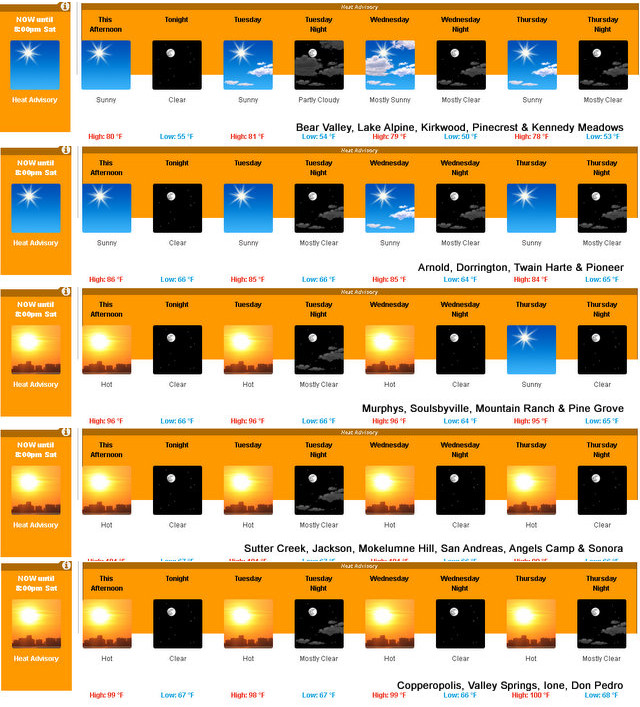Arnold, CA…The National Weather Service in Sacramento has issued a heat advisory for Dangerous Heat into Next Weekend. A prolonged period of very hot temperatures is expected this week and into early next weekend, with valley and foothill highs ranging from the mid 90s to 110. Overnight temperatures will only fall to the mid 60s and 70s, offering little relief. Marine influenced areas may experience slightly cooler overnight lows, but will remain hot during the day. There will be moderate to very high heat risk during this time which may impact the general population as well as those who will be spending extended periods outdoors.

CAZ013>019-063-066>069-231300-
/O.CON.KSTO.HT.Y.0002.000000T0000Z-200628T0300Z/
Shasta Lake Area / Northern Shasta County-
Burney Basin / Eastern Shasta County-Northern Sacramento Valley-
Central Sacramento Valley-Southern Sacramento Valley-
Carquinez Strait and Delta-Northern San Joaquin Valley-
Mountains Southwestern Shasta County to Western Colusa County-
Northeast Foothills/Sacramento Valley-Motherlode-
Western Plumas County/Lassen Park-
West Slope Northern Sierra Nevada-
Including the cities of Shasta Dam, Burney, Redding, Red Bluff,
Chico, Oroville, Marysville/Yuba City, Sacramento,
Fairfield/Suisun, Stockton, Modesto, Alder Springs, Paradise,
Grass Valley, Jackson, Chester, Quincy, and Blue Canyon
147 PM PDT Mon Jun 22 2020
…HEAT ADVISORY REMAINS IN EFFECT UNTIL 8 PM PDT SATURDAY…
* WHAT…Dangerous heat with afternoon highs between 99 and 110
for the Valley and between 92 to 105 for the Foothills. The
hottest daytime temperatures will be found north of
Marysville. Overnight lows in the 60s to 70s.
* WHERE…Sacramento Valley, the northern San Joaquin Valley,
and surrounding foothills.
* WHEN…From noon Monday to 8 PM PDT Saturday.
* IMPACTS…Heat related illnesses such as heat exhaustion and
heat stroke can occur due to prolonged exposure to hot
temperatures, including the general population. People most
vulnerable include those who are spending lots of time
outdoors, those without air conditioning, young children, the
elderly and those with chronic ailments.
* ADDITIONAL DETAILS…Local rivers and streams are running fast
and cold. Cold water safety should be practiced when on and
near the water.
PRECAUTIONARY/PREPAREDNESS ACTIONS…
Drink plenty of fluids, stay in an air-conditioned room, stay out
of the sun, and check up on relatives and neighbors. Young
children and pets should never be left unattended in vehicles
under any circumstances.
Take extra precautions if you work or spend time outside. When
possible reschedule strenuous activities to early morning or
evening. Know the signs and symptoms of heat exhaustion and heat
stroke. Wear lightweight and loose fitting clothing when
possible. To reduce risk during outdoor work, the Occupational
Safety and Health Administration recommends scheduling frequent
rest breaks in shaded or air conditioned environments. Anyone
overcome by heat should be moved to a cool and shaded location.
Heat stroke is an emergency! Call 9 1 1.


